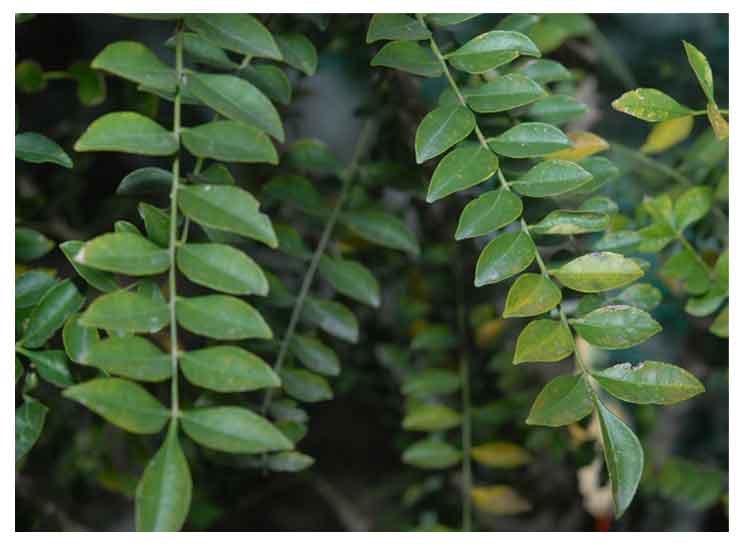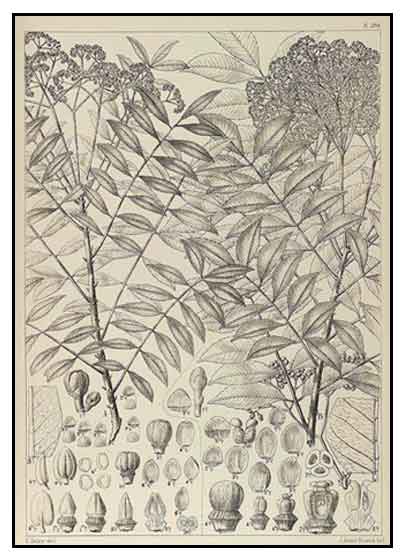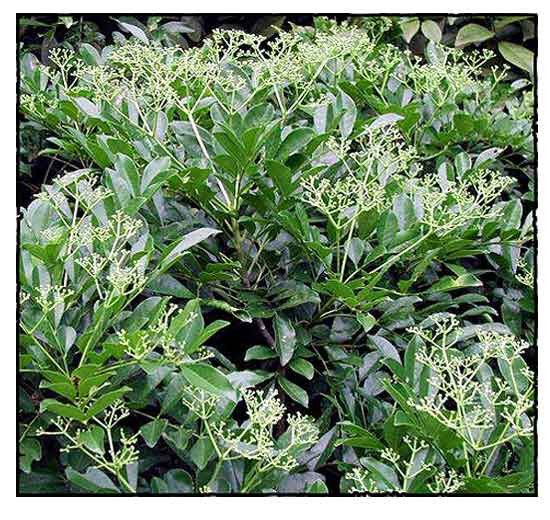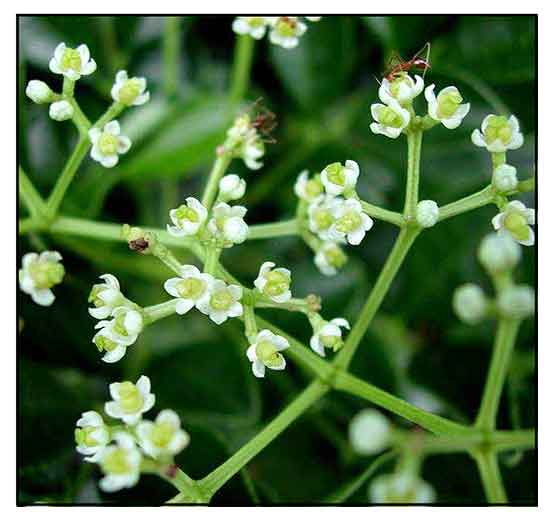 Gen info Gen info
- Zanthoxylum is a genus of about 250 species of deciduous and evergreen trees, shrubs and climbers in the family Rutaceae that are native to warm temperate and subtropical areas worldwide. Several species are cultivated for their use as spices, notably Sichuan pepper.
- The genus Zanthoxylum was first described by Carl Linnaeus in 1753 in the first volume of Species Plantarum.
- Etymology: The genus name Zanthoxylum derives for ancient Greek words xanthos, meaning 'yellow' and xylon, meaning 'wood'. It relates to the yellow dye made from the roots of some species. (13)
Botany
• Kangai is a shrub of 2 or 3 meters in height, with pinnately compound leaves varying considerably in length, sometimes reaching 25 centimeters. Branchlets are unarmed. Leaflets are usually fairly smooth, variable in form and size, ovate, obovate, or oblong-elliptic, the terminal one being largest, averaging 8 centimeters long. Flowers are fairly small, whitish or greenish, borne on the upper axils on depauperate panicles, 8 centimeters or less in length. Fruit is small, 5 to 6 millimeters in diameter. Seeds are black.
 • Z. avicennae is a deciduous tree that reaches 15 meters high. The trunk has chicken-foot-like thorns, the thorn base is oblate and thickened, shaped like a bulge, and displays ring patterns. Leaflets of the seedlings are very small, but as many as 31, on the branches of young trees. Leaves are densely thorny, and each part is glabrous. Leaves have 11-21 leaflets that are usually opposite or occasionally irregularly opposite, obliquely ovoid, obliquely rectangular or sickle-shaped, and are sometimes obovate. Seedling leaflets are mostly broad-ovate, 2.5-7 cm long, 1-3 cm wide, short pointed or blunt at the top, asymmetrical on both sides, with sparsely cracked teeth on the whole or above the middle. The oil spots on fresh leaves are visible, while some are not obvious on the ventral surface of the leaf shaft. Leaf edges are narrow and green, and often narrow wing-shaped. Inflorescence is terminal, with many flowers; the rachis and flowers are hard and sometimes purple-red. Male pedicel is 1-3 mm long. Sepals and petals are 5 mm. Sepals are broadly ovoid and green. Petals are yellow and white. The petals of the female flowers are slightly longer than those of the male flowers. About 2.5 mm long; male flowers have 5 stamens; 2 staminodes are lobed; female flowers have carpels 2 and rarely 3; staminodes are extremely small. Fruit stalk is 3-6 mm long, and the total stalk is 1-3 times longer than the fruit stalk; the stalks are light-purple red, and the diameter of a single stalk is 4-5 mm. The top has no awn tip. The oil spots are large and many, slightly convex. Seed is 3.5-4.5 mm diameter. (12) • Z. avicennae is a deciduous tree that reaches 15 meters high. The trunk has chicken-foot-like thorns, the thorn base is oblate and thickened, shaped like a bulge, and displays ring patterns. Leaflets of the seedlings are very small, but as many as 31, on the branches of young trees. Leaves are densely thorny, and each part is glabrous. Leaves have 11-21 leaflets that are usually opposite or occasionally irregularly opposite, obliquely ovoid, obliquely rectangular or sickle-shaped, and are sometimes obovate. Seedling leaflets are mostly broad-ovate, 2.5-7 cm long, 1-3 cm wide, short pointed or blunt at the top, asymmetrical on both sides, with sparsely cracked teeth on the whole or above the middle. The oil spots on fresh leaves are visible, while some are not obvious on the ventral surface of the leaf shaft. Leaf edges are narrow and green, and often narrow wing-shaped. Inflorescence is terminal, with many flowers; the rachis and flowers are hard and sometimes purple-red. Male pedicel is 1-3 mm long. Sepals and petals are 5 mm. Sepals are broadly ovoid and green. Petals are yellow and white. The petals of the female flowers are slightly longer than those of the male flowers. About 2.5 mm long; male flowers have 5 stamens; 2 staminodes are lobed; female flowers have carpels 2 and rarely 3; staminodes are extremely small. Fruit stalk is 3-6 mm long, and the total stalk is 1-3 times longer than the fruit stalk; the stalks are light-purple red, and the diameter of a single stalk is 4-5 mm. The top has no awn tip. The oil spots are large and many, slightly convex. Seed is 3.5-4.5 mm diameter. (12)
Distribution
- Native to the Philippines.
- In Benguet, Zambales, Nueva Ecija, Rizal, Batangas, and Camarines Provinces in Luzon; in Palawan; and in Mindanao, in thickets and forests, chiefly at medium altitudes, in Benguet, ascending to 2,200 meters.
- Also native to
China Hainan, Laos, Lesser Sunda Is., Thailand, Vietnam.
 Constituents Constituents
- Studies have isolated flavonoids, alkaloids, coumarins and terpenoids.
-
Study yielded bishordeninyl terpene alkaloids from the leaves - (-)-culantraramine and (-)-culantraraminol, together with (-)-culantraramine N-oxide, (-)-culantraraminol N-oxide and avicennamine. (1)
- Bark has yielded hisperidin and diosmin. (Hisperidin appears to strengthen weak capillary vessels and used for treatment of conditions characterized by bleeding.
- Study of an EtOAc-soluble fraction of leaves yielded four new coumarins viz. 5'-methoxy- collinin (1), 5'-methoxyauraptene (2), 7-((2'E,5'E)-7'-methoxy-3',7'-dimethylocta-2',5'-dienyloxy)coumarin (3), 6-methoxy-7-((2'E,5'E)-7'-methoxy-3',7'-dimethylocta-2',5'- dienyloxy)coumarin (4), along with 16 known compounds (5-20). (See study below) (5)
- Study of essential leaf oil yielded more than 50 compounds. Major constituents were sesquiterpene hydrocarbons β-caryophyllene (17.01 %) and α-humulene (10.38 %) as well as the monoterpene hydrocarbons α-pinene (10.07 %) and β-phellandrene. Mono- and sesquiterpene hydrocarbons, such as α-terpinene, (E)-β-ocimene, λ-terpinene, germacrene D and β-selinene, were found in concentrations higher than 3.0 %. (8)
- Study of essential oil of stems and leaves yielded a total of 31 components, with monoterpenoids (66.70%) higher than sesquiterpenoids (33.45%). Principal compounds were 1,8-cineol (53.05 %), β-elemene (6.13 %), α-caryophyllene (5.96 %), β-caryophyllene (5.09 %) and caryophyllene oxide (4.59 %). (see study below) (10)
 - Study of EtOAc extract of root and stem yielded fourteen compounds, viz., Avicennin (1), Xanthoxyletin (2), Luvangetin (3), Norchelerythrine (4), Diisobutyl phthalate (5), ß- amyrin (6), Lupeol (7), Chelerythrine (8), Dictamine (9), ÷-fagarine (10) and Skimmianine (11), Sesamin (12) Syringaresinol (13) and P-hydroxybenzoic acid (14). (11) - Study of EtOAc extract of root and stem yielded fourteen compounds, viz., Avicennin (1), Xanthoxyletin (2), Luvangetin (3), Norchelerythrine (4), Diisobutyl phthalate (5), ß- amyrin (6), Lupeol (7), Chelerythrine (8), Dictamine (9), ÷-fagarine (10) and Skimmianine (11), Sesamin (12) Syringaresinol (13) and P-hydroxybenzoic acid (14). (11)
- Study of leaves isolated five new coumarins,
5′-methoxyauraptene (1), 6,5′-dimethoxyauraptene (2), 5′-methoxycollinin (3), 7-((2′E,5′E)-7′-methoxy-3′,7′-dimethylocta-2′,5′-dienyloxy)coumarin (4), and 6-methoxy-7-((2′E,5′E)-7′-methoxy-3′,7′-dimethylocta-2′,5′-dienyloxy)coumarin (5), along with 15 known compounds (6-20). (see study below) (14)
- GC-MS study of leaves for volatile oil
yielded 68 kinds of compounds representing 97.89% of total peak area. Main ingredients were sesquiterpenoids and monoterpene. (see study below) (15)
-Study of bark and leaves isolated and purified three antifungal compounds, identified as xanthyletin (1), luvangetin (2), and avicennin (3). (see study below) (16)
- Hydrodistillation and GC-MS studies of leaves and twigs for essential oil
identified 42 and 53 compounds, respectively. Mono- and sesquiterpenes were the main chemical classes in both oils. Major constituents of leaf oil were β-caryophyllene (18.71 %), α-humulene (14.03 %), α-terpinene (10.65 %), γ-terpinene (10.64 %), and linalool (9.42 %). Major constituents of the twig oil were linalool (18.3 %), β-phellandrene (8.82 %), α-terpinene (7.85 %), o-cymene (7.79 %), γ-terpinene (7.99 %), and (E)-β-ocimene (6.62 %). (18)
Properties
- The fresh leaves, root bark and pericarp all have the smell of pepper, chewing sticky, bitter and numb. Pericarp and root bark have a strong flavor.
-
Bark is bitter; considered astringent and tonic.
- Studies suggest cytotoxicity, anti-inflammatory, anticancer, larvicidal, antimicrobial properties.
Parts used
Stems, roots, leaves, bark.
 Uses Uses
Edibility
- Fruits are edible; used as a spice, with a smell of anise.
- Leaves used to flavor food, with a smell of coriander. (20)
Folkloric
- Decoction of stem used as stomach tonic; also, used as antidote for snake bites.
- Bark used as tonic.
- In China, used in treatment of rheumatism, abdominal pain, jaundice, chronic hepatitis and common cold. (5)
- In Taiwan, used for epigastric pain, vomiting, diarrhea, abdominal pain due to intestinal parasites; used externally for eczema. (5)
- The Chaoshan in Guangdong, China use decoction of roots and leaves for rheumatoid arthritis and traumatic injury. (19)
Others
- Wood: Reddish wood is hard, dense and heavy. Used for making small tool handles.
Studies
• Neolignans / Anti-Inflammatory: Study of stem wood of ZA yielded 8 new compounds, including four new neolignans, together with 18 known compounds. The MeOH extract of Z. avicennae inhibited FMLP/CB- induced superoxide anion generation by human neutrophils and elastase release in a
concentration-dependent manner. (2)
• Anti-Cancer / Cell Apoptosis / Hepatocellular Carcinoma: Study investigating the effects of Ying Bu Bo extracts on HA22T human hepatocellular carcinoma cells in vitro and an in vivo mouse xenograft model showed dose-dependent induction of apoptosis, up-regulated death receptor apoptotic pathway markers and mitochondrial proteins, and suppressed protein survival. Results indicates YBBEs significantly promoted dose-dependent HA22T apoptosis and reduced tumor sizes in xenograft mice model. (3)
• Bioactive Constituents / Coumarins / Anti-Inflammatory / Leaves: Study of an EtOAc-soluble fraction of leaves yielded four new coumarins, along with 16 known compounds (See constituents above). Some compounds inhibited superoxide anion generation by human neutrophils in response to fMLP/CB. Compounds 8, 14 and 18 inhibited fMLP/CB-induced elastase release. (5)
• Essential Oil / Antibacterial / Antitumor: Essential oil from leaves yielded 72 components. The essential oil exhibited strong antitumor activity against K-562 human tumor cell line and exhibited moderate antimicrobial activity against three bacteria. (6)
• Larvicidal / Essential Oil / Stems and Leaves: Study evaluated the larvicidal activity of essential oil derived from Z. avicennae leaves and stems against larvae of Aedes albopictus Skuse. The essential oil showed larvicidal activity against A. albopictus with a median lethal concentration (LC50) of 48.79 µg/mL. (see constituents above) (10)
• Coumarins / Anti-Inflammatory / Leaves: Study of leaves isolated five new coumarins, along with 15 known compounds (6-20). Compounds 6, 9-15 and 18 exhibited inhibition of superoxide anion generation by human neutrophils (IC50 ≤8.29 µg/ml). Compounds 6, 10, 12, 14, and 18 inhibited fMLP/CB-induced elastase with IC50s ≤6.30 µg/ml). Compounds 10 and 14 are potential candidates for treatment of inflammatory diseases. (see constituents above) (14)
• Antimicrobial / Cytotoxicity / Volatile Oil / Leaves: Study of leaves for volatile oil revealed 68 kinds of compounds accounting for 97.89% of total peak area. The volatile oil showed strong antibacterial activities and cytotoxicity, with strongest antibacterial activity against Rhizoctonia solani AG1-1A. (15)
• Antifungal / Bark and Leaves: Study of bark and leaves isolated and purified three antifungal compounds, identified as xanthyletin (1), luvangetin (2), and avicennin (3). The compounds showed good antifungal activities against F. graminearum, R. solani, and P. oryae. (16)
• Inhibition of Cell Proliferation Through PP2A Activation / Hepatocellular Carcinoma: Study evaluated the in vitro and in vivo mechanism of Z. avicennae on inhibition of HA22T human hepatocellular carcinoma cell proliferation. HA22T cells were treated with different concentrations of Z. avicennae extracts (YBBEs). YBBEs showed strong inhibition of HA22T cell viability in a dose dependent manner and significantly reduced cell proliferation-related proteins and induced cell cycle arrest in G2/M phase. YBBEs inhibited HA22T tumor cell growth and downregulated survival and cell cycle regulating proteins, and activated PP2A protein. Results suggest inhibition of HA22T proliferation by YBBEs was mediated through PP2A activation. (also see 3 above) (17)
Availability
Wild-crafted.
|

![]()




 • Z. avicennae is a deciduous tree that reaches 15 meters high. The trunk has chicken-foot-like thorns, the thorn base is oblate and thickened, shaped like a bulge, and displays ring patterns. Leaflets of the seedlings are very small, but as many as 31, on the branches of young trees. Leaves are densely thorny, and each part is glabrous. Leaves have 11-21 leaflets that are usually opposite or occasionally irregularly opposite, obliquely ovoid, obliquely rectangular or sickle-shaped, and are sometimes obovate. Seedling leaflets are mostly broad-ovate, 2.5-7 cm long, 1-3 cm wide, short pointed or blunt at the top, asymmetrical on both sides, with sparsely cracked teeth on the whole or above the middle. The oil spots on fresh leaves are visible, while some are not obvious on the ventral surface of the leaf shaft. Leaf edges are narrow and green, and often narrow wing-shaped. Inflorescence is terminal, with many flowers; the rachis and flowers are hard and sometimes purple-red. Male pedicel is 1-3 mm long. Sepals and petals are 5 mm. Sepals are broadly ovoid and green. Petals are yellow and white. The petals of the female flowers are slightly longer than those of the male flowers. About 2.5 mm long; male flowers have 5 stamens; 2 staminodes are lobed; female flowers have carpels 2 and rarely 3; staminodes are extremely small. Fruit stalk is 3-6 mm long, and the total stalk is 1-3 times longer than the fruit stalk; the stalks are light-purple red, and the diameter of a single stalk is 4-5 mm. The top has no awn tip. The oil spots are large and many, slightly convex. Seed is 3.5-4.5 mm diameter. (
• Z. avicennae is a deciduous tree that reaches 15 meters high. The trunk has chicken-foot-like thorns, the thorn base is oblate and thickened, shaped like a bulge, and displays ring patterns. Leaflets of the seedlings are very small, but as many as 31, on the branches of young trees. Leaves are densely thorny, and each part is glabrous. Leaves have 11-21 leaflets that are usually opposite or occasionally irregularly opposite, obliquely ovoid, obliquely rectangular or sickle-shaped, and are sometimes obovate. Seedling leaflets are mostly broad-ovate, 2.5-7 cm long, 1-3 cm wide, short pointed or blunt at the top, asymmetrical on both sides, with sparsely cracked teeth on the whole or above the middle. The oil spots on fresh leaves are visible, while some are not obvious on the ventral surface of the leaf shaft. Leaf edges are narrow and green, and often narrow wing-shaped. Inflorescence is terminal, with many flowers; the rachis and flowers are hard and sometimes purple-red. Male pedicel is 1-3 mm long. Sepals and petals are 5 mm. Sepals are broadly ovoid and green. Petals are yellow and white. The petals of the female flowers are slightly longer than those of the male flowers. About 2.5 mm long; male flowers have 5 stamens; 2 staminodes are lobed; female flowers have carpels 2 and rarely 3; staminodes are extremely small. Fruit stalk is 3-6 mm long, and the total stalk is 1-3 times longer than the fruit stalk; the stalks are light-purple red, and the diameter of a single stalk is 4-5 mm. The top has no awn tip. The oil spots are large and many, slightly convex. Seed is 3.5-4.5 mm diameter. (


